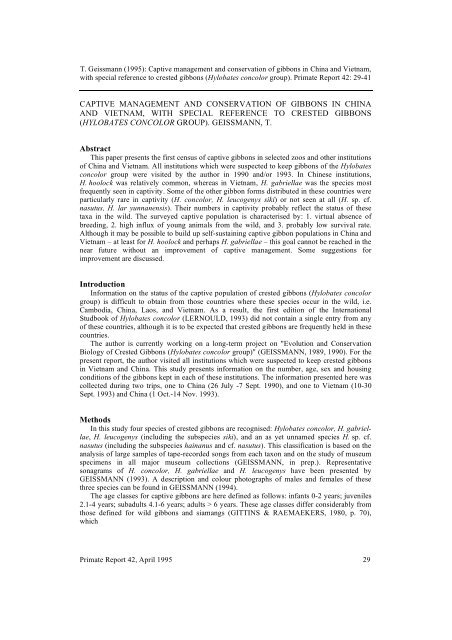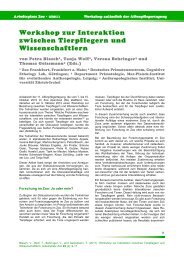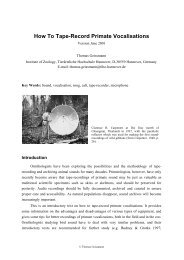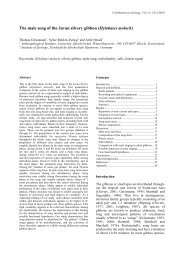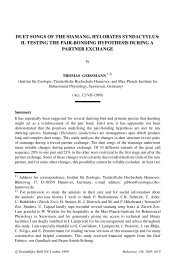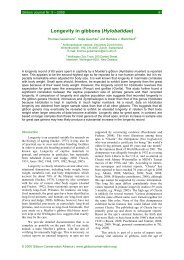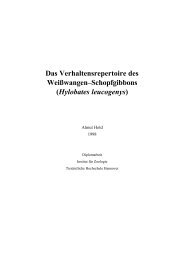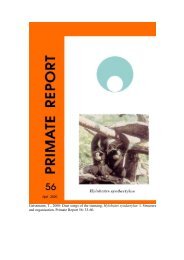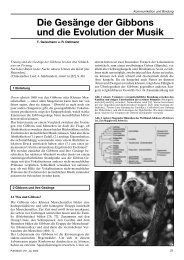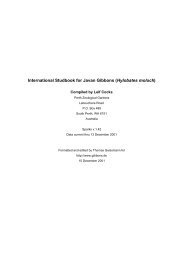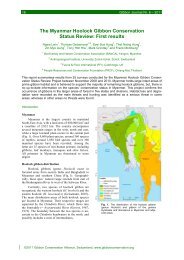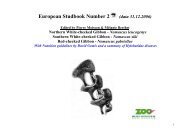captive management and conservation of gibbons in china and ...
captive management and conservation of gibbons in china and ...
captive management and conservation of gibbons in china and ...
You also want an ePaper? Increase the reach of your titles
YUMPU automatically turns print PDFs into web optimized ePapers that Google loves.
T. Geissmann: Gibbons <strong>in</strong> Ch<strong>in</strong>a <strong>and</strong> VietnamTable 1 (ctd.)Species <strong>in</strong> Zoos Age class Totalad. subad. juv. <strong>in</strong>f. <strong>in</strong>det.Guangzhou Zoo, Sept. 1990, <strong>and</strong> Oct. 1993H. hoolock, 1990 (1,0) (1,1 +5) (2,1 +5)H. hoolock, 1993 2,2 2,0 4,2H. agilis albibarbis, 1990 + 1,0 1,01993Shanghai Zoo, Oct. 1993H. hoolock 1,0 1,0 1,0Beij<strong>in</strong>g Zoo, Oct.-Nov. 1993H. gabriellae 1,0 +2 1,0 +2H. leucogenys leucogenys 1,0 1,0H. leucogenys siki 0,1 0,1H. hoolock 1,2 1,0 2,2H. lar 1,0 1,0Beij<strong>in</strong>g Center for Breed<strong>in</strong>g Endangered Animals, Nov. 1993H. hoolock 1,0 1,0 2,0VietnamSaigon Zoo, Nov. 1993H. gabriellae 1,1 2,0 3,1H. pileatus 0,1 0,1Hanoi Zoo, Nov. 1993H. gabriellae 1,0 1,0H. leucogenys leucogenys 1,0 2 1,0 +2Primate Rescue Station, Cuc Phuong, Sept. 1993H. leucogenys siki 0,1 0,1Total 2H. conocolor 2,2 2,2H. concolor (x H. leucogenys ?) 0,1 0,1H. gabriellae 1,1 2,0 2,0 +2 5,1 +2H. leucogenys leucogenys 2,1 1,0 1,0 +2 5 4,1 +7H. leucogenys siki 0,1 0,1 0,2H. hoolock 4,7 7,1 7,7 1,0 3 19,15 +3H. agilis albibarbis 1,0 1,0H. lar 1,0 1,0H. pileatus 0,1 0,1Ch<strong>in</strong>a 10,11 7,1 9,8 +2 1,0 +5 3 27,20 +10Vietnam 1,1 3,0 1,1 +2 0,1 5,3 +2Ch<strong>in</strong>a <strong>and</strong> Vietnam 11,12 10,1 10,9 +4 1,1 +5 3 32,23 +121Commas separate males, females, gender unknown.2Guangzhou Zoo was visited twice, i.e. <strong>in</strong> Sept. 1990 <strong>and</strong> Oct. 1993. The more recent dataare used for the totals <strong>in</strong> this table.Primate Report 42, April 1995 31
T. Geissmann: Gibbons <strong>in</strong> Ch<strong>in</strong>a <strong>and</strong> VietnamPrimates kept as pets were not frequently encountered. The author was especially <strong>in</strong>terested<strong>in</strong> see<strong>in</strong>g pet <strong>gibbons</strong>, but, despite <strong>in</strong>quiry, found evidence <strong>of</strong> only two such pets. One youngcrested gibbon was reportedly kept <strong>in</strong> N<strong>in</strong>h B<strong>in</strong>h, northern Vietnam (not seen), another petcrested gibbon, a female H. gabriellae, was held at Dak Lua Market <strong>in</strong> the Nam Bai Cát TiênNational Park (Dông Nai Prov<strong>in</strong>ce, southern Vietnam).DiscussionHoolock Gibbons (H. hoolock):In Ch<strong>in</strong>a, hoolocks are the most frequent <strong>captive</strong> species (8 <strong>of</strong> 9 <strong>in</strong>stitutions). Only 30% <strong>of</strong>these animals are adult (Fig. 1). The large number <strong>of</strong> <strong>captive</strong> immature hoolocks seen dur<strong>in</strong>gthis study (26 <strong>of</strong> 37 animals) permits several conclusions: 1. There appears to be a large supply<strong>of</strong> young <strong>gibbons</strong> <strong>of</strong> this species available on the pet market. 2. In view <strong>of</strong> the few hoolocksestimated to survive <strong>in</strong> their natural habitat <strong>in</strong> Ch<strong>in</strong>a (about 50-200: HAIMOFF et al., 1986,1987; TAN, 1985; TAN & POIRIER, 1988; YANG et al., 1987), the supply <strong>of</strong> <strong>captive</strong>hoolocks may, at least <strong>in</strong> part, come from eastern Burma. 3. The relatively large number <strong>of</strong>hoolocks held <strong>in</strong> Ch<strong>in</strong>ese <strong>in</strong>stitutions would seem to hold some promise for breed<strong>in</strong>g thisspecies. On closer exam<strong>in</strong>ation, the road to a self-susta<strong>in</strong><strong>in</strong>g <strong>captive</strong> population may still be out<strong>of</strong> sight: Apparently this species has never bred <strong>in</strong> captivity <strong>in</strong> Ch<strong>in</strong>a. Most animals are kept <strong>in</strong>solitary conf<strong>in</strong>ement or are too young to breed, <strong>and</strong> the author saw only one adult pair (Beij<strong>in</strong>gZoo).Crested Gibbons (H. concolor Group):In contrast to hoolocks, <strong>captive</strong> <strong>gibbons</strong> <strong>of</strong> the concolor group are relatively rare <strong>in</strong> the<strong>in</strong>stitutions visited dur<strong>in</strong>g this study (kept <strong>in</strong> 6 <strong>of</strong> 12 <strong>in</strong>stitutions).Fig. 1: Adult female hoolock (Hylobateshoolock) "Gui-Gui" at Kunm<strong>in</strong>g Zoo (5Aug. 1990).Fig. 2: Adult black crested <strong>gibbons</strong> (H.concolor) at Gejiu Zoo: male "Dong-Dong" (with female "Hong-Hong" <strong>in</strong> thebackground).32 Primate Report 42, April 1995
T. Geissmann: Gibbons <strong>in</strong> Ch<strong>in</strong>a <strong>and</strong> VietnamIt may be significant that all reliably identified <strong>captive</strong> black crested <strong>gibbons</strong> (H. concolor)live <strong>in</strong> one zoo <strong>and</strong> all are adult (Fig. 2). It appears that these <strong>gibbons</strong> are so rare <strong>in</strong> the wild,that, even <strong>in</strong> their home countries, they have nearly disappeared from the animal market <strong>and</strong> thesupply <strong>of</strong> young animals may be exhausted. All <strong>captive</strong> animals can be identified as H.concolor, i.e. they were caught west <strong>of</strong> the Red River. No <strong>captive</strong> animal <strong>of</strong> the unnamedspecies east <strong>of</strong> the Red River (GEISSMANN, <strong>in</strong> prep.) was seen, which suggests that the status<strong>of</strong> this species <strong>in</strong> the wild may be even more critical. The last animals on the ma<strong>in</strong>l<strong>and</strong> whichcan be reliably identified as belong<strong>in</strong>g to the unnamed species were collected <strong>in</strong> June 1965 <strong>in</strong>Cao Bang Prov<strong>in</strong>ce.An adult female crested gibbon kept at the Kunm<strong>in</strong>g Zoo was <strong>of</strong> particular <strong>in</strong>terest (Fig. 3):She had reportedly arrived from Mengla County. The author was told <strong>in</strong>dependently by twostaff members that this female was a white-cheeked gibbon (H. leucogenys) <strong>and</strong> that thejuvenile coat <strong>of</strong> this animal had <strong>in</strong>cluded white cheeks, as <strong>in</strong> H. leucogenys. In contrast to this<strong>in</strong>formation, the fur colouration <strong>and</strong> the song vocalisations <strong>of</strong> the adult animal resembledH. concolor. As one solution to the contradictory evidence on this female, one could disregardall <strong>in</strong>formation provided by the zoo <strong>and</strong> consider her a pure H. concolor.Alternatively, this gibbon could be a hybrid between H. concolor <strong>and</strong> H. l. leucogenys. Likethe Kunm<strong>in</strong>g female, all true hybrids H. concolor x H. leucogenys leucogenys bred at theTwycross Zoo resembled H. leucogenys leucogenys when <strong>in</strong> the black coat stage (Figure 4).Among these hybrids, an adult female did not reta<strong>in</strong> black underparts, however, but had a lightbelly, like H. leucogenys (Mr. S. Eddie, pers. comm.). It is unknown whether this trait isvariable <strong>in</strong> these hybrids. In addition, the Twycross hybrids are all from the first hybridgeneration, while the Kunm<strong>in</strong>g animal's hybrid l<strong>in</strong>e could be several generations long. BecauseFig. 3: Possible hybrid between H. concolor<strong>and</strong> H. leucogenys: Adult female"Xiao Shuang" at Kunm<strong>in</strong>g Zoo (5 Aug.1990).Fig. 4: Juvenile female hybrid (H. concolorx H. leucogenys) "Zilla" (HencottFarm, Shrewsbury, 5 Oct. 1988).Primate Report 42, April 1995 33
T. Geissmann: Gibbons <strong>in</strong> Ch<strong>in</strong>a <strong>and</strong> Vietnamthe <strong>in</strong>terviewees both reported the white cheeks <strong>in</strong>dependently, their <strong>in</strong>formation can beregarded as a strong support for the identification <strong>of</strong> the Kunm<strong>in</strong>g female as a hybrid. The<strong>in</strong>formation about the animal's provenance (Mengla County), however, is almost certa<strong>in</strong>lywrong, <strong>in</strong>dependently <strong>of</strong> whether the animal is a pure H. concolor or a hybrid. OnlyH. leucogenys is known to occur <strong>in</strong> Mengla County, but not H. concolor (FOODEN et al.,1987; MA & WANG, 1986; YANG et al., 1987). On the other h<strong>and</strong>, a zone <strong>of</strong> overlap betweenthe distribution ranges <strong>of</strong> both species has been reported to occur <strong>in</strong> the Huanglian mounta<strong>in</strong>s <strong>in</strong>Luchun County, southern Yunnan (MA & WANG, 1986; MA et al., 1988). The population <strong>of</strong>H. leucogenys <strong>in</strong> that region is probably now ext<strong>in</strong>ct (ZHANG et al., 1992: their Fig. 6). Twoother regions <strong>of</strong> overlap may occur <strong>in</strong> Vietnam (DAO VAN TIEN, 1983). The Kunm<strong>in</strong>g femalemay, therefore, have been caught <strong>in</strong> one <strong>of</strong> these regions, if she is a hybrid.Fig. 5: Juvenile female <strong>of</strong> the southern whitecheekedcrested gibbon (H. leucogenys siki) atBeij<strong>in</strong>g Zoo (12 Nov. 1993).In contrast to the black crested gibbon(H. concolor), light-cheeked crested <strong>gibbons</strong>do not appear to be short <strong>in</strong> supply,especially <strong>in</strong> Vietnam. The large number <strong>of</strong>crested <strong>gibbons</strong> (mostly H. gabriellae)available until recently at the animal market<strong>in</strong> Ho Chi M<strong>in</strong>h City has been mentioned <strong>in</strong>previous publications (ANONYMOUS,1992, EAMES & ROBSON, 1993). Theanimal market <strong>in</strong> Ho Chi M<strong>in</strong>h City wasclosed <strong>in</strong> 1993, but not the one <strong>in</strong> Hanoi,where <strong>gibbons</strong> are frequently available (Mr.T. Nadler, pers. comm.). An <strong>in</strong>fant gibbon(H. leucogenys siki) obta<strong>in</strong>ed there dur<strong>in</strong>gthe present study was transferred to thePrimate Rescue Center <strong>in</strong> Cuc Phuong, asmentioned above. No <strong>gibbons</strong> were seen <strong>in</strong>the animal markets <strong>of</strong> Kunm<strong>in</strong>g (1990) orJ<strong>in</strong>ghong (1990), <strong>and</strong> no primates at all wereseen <strong>in</strong> the animal market <strong>of</strong> Guangzhou(1993).Some <strong>of</strong> the <strong>captive</strong> crested <strong>gibbons</strong> atthe Beij<strong>in</strong>g Zoo were identified as H.gabriellae <strong>and</strong> H. leucogenys siki (Fig. 5).These taxa do not occur <strong>in</strong> the wild <strong>in</strong> Ch<strong>in</strong>a.They were obta<strong>in</strong>ed by Beij<strong>in</strong>g Zoo fromKunm<strong>in</strong>g <strong>in</strong> Yunnan Prov<strong>in</strong>ce, which sharesborders with both Laos <strong>and</strong> Vietnam. There appears to be a successfully operat<strong>in</strong>g route forgibbon traffic from one or both <strong>of</strong> these countries through Yunnan Prov<strong>in</strong>ce.H. lar Group:Gibbons <strong>of</strong> the lar group were found <strong>in</strong> only 3 <strong>of</strong> the 12 <strong>in</strong>stitutions visited dur<strong>in</strong>g thisstudy. The distribution <strong>of</strong> the lar group occurs ma<strong>in</strong>ly outside Ch<strong>in</strong>a; only H. lar is found <strong>in</strong> asmall region <strong>of</strong> Western Yunnan (FOODEN et al., 1987; MA & WANG, 1986; MA et al.,1988; YANG et al., 1987). The species may now be ext<strong>in</strong>ct <strong>in</strong> this region (Yang, 1993). No<strong>gibbons</strong> <strong>of</strong> the lar group are known to occur <strong>in</strong> Vietnam <strong>in</strong> the wild. It has been repeatedlymentioned that one34 Primate Report 42, April 1995
T. Geissmann: Gibbons <strong>in</strong> Ch<strong>in</strong>a <strong>and</strong> Vietnamspecies <strong>of</strong> the lar group, H. pileatus, occurs on Phu Quoc isl<strong>and</strong> (i.e. Vietnamese territory) (BÔKHOA HOC, 1992; van PEENEN et al., 1969), but there is, as yet, no reliable evidence for thisclaim. This idea apparently orig<strong>in</strong>ated from BOURRET (1946?), who suggested that the typelocality <strong>of</strong> H. pileatus ("a small isl<strong>and</strong> near Camboja", GRAY, 1861, p. 135) probably referredto Phu Quoc. Later, SIMONETTA (1957, p. 64) simply changed the type locality to Phu Quoc,without reveal<strong>in</strong>g his source <strong>of</strong> evidence. All <strong>gibbons</strong> <strong>of</strong> the lar group seen dur<strong>in</strong>g this studyare, therefore, likely to have been have imported (1 H. lar via Japan, 1 H. agilis albibarbis fromsouthwest Kalimantan, <strong>and</strong> 1 H. pileatus possibly from Cambodia or Laos).Age distribution:The <strong>captive</strong> gibbon population <strong>of</strong>Ch<strong>in</strong>a <strong>and</strong> Vietnam <strong>in</strong>cludes a relativelyhigh percentage <strong>of</strong> juvenile animals (36%). This is as high as the percentage <strong>of</strong>adult animals, as shown <strong>in</strong> Figure 6. Forcomparison, the values <strong>of</strong> the <strong>captive</strong>population <strong>of</strong> crested <strong>gibbons</strong> covered bythe first edition <strong>of</strong> the InternationalStudbook (LERNOULD, 1993, p. 93) arealso shown. The studbook sample <strong>in</strong>cludesonly 11% juveniles, but 64%adults. Almost all <strong>of</strong> these animals arekept <strong>in</strong> western countries <strong>and</strong> there is nooverlap with the gibbon sample exam<strong>in</strong>eddur<strong>in</strong>g this study.The difference <strong>in</strong> the age class distribution<strong>of</strong> the two samples can betentatively <strong>in</strong>terpreted as follows: In thestudbook sample, there is a large proportion<strong>of</strong> adults. Many <strong>of</strong> these animalswere apparently not breed<strong>in</strong>g at the time<strong>of</strong> the census, but the population appearsto have a high survival rate. In contrast,reproduction is virtually absent <strong>in</strong> the<strong>captive</strong> gibbon population <strong>of</strong> Ch<strong>in</strong>a <strong>and</strong>Vietnam. An apparently constant <strong>in</strong>flux<strong>of</strong> new, wild-caught animals makes up thehigh proportion <strong>of</strong> juvenile animals <strong>in</strong> thissample, but the survival rate <strong>of</strong> thejuveniles is apparently lower than <strong>in</strong> thestudbook sample.% <strong>of</strong> <strong>captive</strong> population806040200<strong>in</strong>f. juv. subad. ad.Age classCaptive <strong>gibbons</strong> <strong>in</strong> Ch<strong>in</strong>a <strong>and</strong> Vietnam"International Studbook Hylobates concolor"Fig. 6: Frequency (<strong>in</strong> %) <strong>of</strong> the four age classesamong a) <strong>captive</strong> <strong>gibbons</strong> <strong>in</strong> Ch<strong>in</strong>a <strong>and</strong> Vietnam(this study, n = 64), b) <strong>captive</strong> <strong>gibbons</strong> <strong>of</strong> theconcolor group accord<strong>in</strong>g to the "InternationalStudbook Hylobates concolor" (LERNOULD,1991, n = 181).Recommendations:The <strong>captive</strong> gibbon population <strong>in</strong> Ch<strong>in</strong>a <strong>and</strong> Vietnam could be <strong>of</strong> considerable importancefor <strong>conservation</strong> <strong>of</strong> these species, <strong>in</strong> view <strong>of</strong> their critical status <strong>in</strong> the wild. In the long run, themost reliable action plan should probably consist <strong>in</strong> build<strong>in</strong>g up self-susta<strong>in</strong><strong>in</strong>g <strong>captive</strong> gibbonpopulations with the ultimate goal <strong>of</strong> re<strong>in</strong>troduc<strong>in</strong>g <strong>captive</strong>-bred surplus animals <strong>in</strong>to suitablehabitats where a species has become ext<strong>in</strong>ct or too decimated to survive.Primate Report 42, April 1995 35
T. Geissmann: Gibbons <strong>in</strong> Ch<strong>in</strong>a <strong>and</strong> VietnamIt may be possible to build up self-susta<strong>in</strong><strong>in</strong>g <strong>captive</strong> gibbon populations <strong>in</strong> Ch<strong>in</strong>a <strong>and</strong>Vietnam, at least <strong>of</strong> H. hoolock <strong>and</strong> perhaps H. gabriellae. This goal is not with<strong>in</strong> immediatereach, however, because the breed<strong>in</strong>g success <strong>of</strong> <strong>gibbons</strong> <strong>in</strong> captivity has been so far practicallynil <strong>in</strong> both countries. The most immediate action should, therefore, be to ensure that the <strong>captive</strong><strong>gibbons</strong> breed. This could probably be facilitated by improv<strong>in</strong>g the <strong>management</strong> <strong>and</strong> liv<strong>in</strong>gconditions <strong>of</strong> <strong>captive</strong> <strong>gibbons</strong>. A few suggestions for such improvement are provided below:1. Cage size: Many enclosures should be larger, <strong>in</strong> order to accommodate a gibbon group(Figure 7). In a recent gibbon hous<strong>in</strong>g survey, MOORE <strong>and</strong> WHITELEY MOORE (1992,p. 196) recommended "a m<strong>in</strong>imum primary enclosure size <strong>of</strong> 7x4x4m high for s<strong>in</strong>gleanimals or pairs, with larger areas for reproductive pairs <strong>and</strong> family groups."Fig. 7: Gibbon house at Saigon Zoo (25 Sept. 1993).2. Cage furniture: In many <strong>of</strong> the <strong>in</strong>stitutions visited, the enclosures for <strong>gibbons</strong> (<strong>and</strong> also forother primates) were completely bare (Figure 8). Accord<strong>in</strong>g to MOORE <strong>and</strong> WHITELEYMOORE (1992, p. 199), the quality <strong>of</strong> cage furniture may be at least as important as thequantity, or the size <strong>of</strong> the enclosure. A diverse environment not only meets the needs <strong>of</strong> abreed<strong>in</strong>g family group, but can also be furnished by relatively simple <strong>and</strong> cheap means suchas the provision <strong>of</strong> ropes, bars, poles <strong>and</strong> branches. In some zoos, <strong>gibbons</strong> are kept on smallisl<strong>and</strong>s. This approach may be <strong>of</strong> particular <strong>in</strong>terest to zoos <strong>in</strong> the tropics, where the absence<strong>of</strong> freez<strong>in</strong>g temperatures makes it possible to keep <strong>gibbons</strong> outdoors the whole year long.Isl<strong>and</strong> sett<strong>in</strong>gs with natural vegetation are not only extremely attractive to visitors but alsocome closer to imitat<strong>in</strong>g a naturalistic environment than most <strong>in</strong>door enclosures (Figure 9).36 Primate Report 42, April 1995
T. Geissmann: Gibbons <strong>in</strong> Ch<strong>in</strong>a <strong>and</strong> VietnamFig. 8: Infant hoolock (H. hoolock) at theKunm<strong>in</strong>g Institute <strong>of</strong> Zoology (4 Aug. 1990).Fig. 9: Gibbon isl<strong>and</strong> at Saigon Zoo (25 Sept. 1993).Primate Report 42, April 1995 37
T. Geissmann: Gibbons <strong>in</strong> Ch<strong>in</strong>a <strong>and</strong> Vietnam3. Distance between gibbon groups: Keep<strong>in</strong>g gibbon groups <strong>in</strong> adjacent cages <strong>in</strong> full view <strong>of</strong>each other (see Figure 2) may be stressful to many <strong>of</strong> these territorial animals. Such sett<strong>in</strong>gshave repeatedly created problems (IBSCHER, 1964), which may eventually lead to stressrelatedsickness or even death <strong>of</strong> animals (GEISSMANN, unpubl. observations). Visualcontact between gibbon groups <strong>in</strong> adjacent cages should be made impossible by a sightbarrier. Another solution would be not to keep gibbon groups <strong>in</strong> adjacent cages at all, butonly <strong>in</strong> every second cage <strong>of</strong> a row.4. Social unit: The natural social unit <strong>of</strong> <strong>gibbons</strong> consists <strong>of</strong> territorial family groups. Bycontrast, many zoos visited dur<strong>in</strong>g this survey kept <strong>gibbons</strong> alone or <strong>in</strong> peer groups <strong>of</strong> up to6 animals. Clearly, the coord<strong>in</strong>ated exchange <strong>of</strong> animals between zoos could help to br<strong>in</strong>gpairs together. If peer groups <strong>in</strong>clude several subadult or even adult animals <strong>of</strong> the samesex, extremely violent agonistic <strong>in</strong>teractions may eventually occur, which can lead to thedeath <strong>of</strong> the animals <strong>in</strong>volved. This risk is considerably lower when the <strong>gibbons</strong> are kept <strong>in</strong>pairs. In addition, it has been suggested that immature animals kept as pairs with a potentialmate may reach the age <strong>of</strong> sexual maturity earlier than animals rema<strong>in</strong><strong>in</strong>g <strong>in</strong> their familygroups (GEISSMANN, 1990) <strong>and</strong> possibly also those rema<strong>in</strong><strong>in</strong>g <strong>in</strong> peer groups. Because itmay be difficult to f<strong>in</strong>d suitable mates for gibbon taxa which do not belong to the localfauna, the possibility <strong>of</strong> exchang<strong>in</strong>g rare <strong>gibbons</strong> such as H. leucogenys siki (Beij<strong>in</strong>g Zoo)or H. pileatus (Saigon Zoo) with foreign zoos should also be considered.5. Confiscation <strong>of</strong> <strong>gibbons</strong> from animal markets: Ch<strong>in</strong>ese <strong>and</strong> Vietnamese governments shouldbe urged to enforce the immediate confiscation <strong>of</strong> all endangered primates from animaldealers. This would not only make the deal<strong>in</strong>g <strong>of</strong> these animals more difficult, but wouldalso enlarge the number <strong>of</strong> <strong>gibbons</strong> available for establish<strong>in</strong>g a self-susta<strong>in</strong><strong>in</strong>g <strong>captive</strong>population <strong>and</strong> – <strong>in</strong> the long run – the number <strong>of</strong> <strong>gibbons</strong> available for re<strong>in</strong>troduction <strong>in</strong>totheir natural habitat.Conclusions1. This paper presents the first census <strong>of</strong> <strong>captive</strong> <strong>gibbons</strong> <strong>in</strong> Ch<strong>in</strong>a <strong>and</strong> Vietnam, with specialattention be<strong>in</strong>g paid to zoos <strong>and</strong> other <strong>in</strong>stitutions which were suspected to keep <strong>gibbons</strong> <strong>of</strong>the Hylobates concolor group.2. In Ch<strong>in</strong>ese <strong>in</strong>stitutions, H. hoolock was relatively common; whereas <strong>in</strong> Vietnam, H.gabriellae was the species most frequently seen <strong>in</strong> captivity. Some <strong>of</strong> the other gibbonforms with distributions <strong>in</strong> these countries were particularly rare <strong>in</strong> captivity (H. concolor,H. leucogenys siki), or not seen at all (H. sp. cf. nasutus, H. lar yunnanensis). Their lownumbers <strong>in</strong> captivity probably reflect the status <strong>of</strong> these taxa <strong>in</strong> the wild.3. The surveyed <strong>captive</strong> population is characterised by: 1. virtual absence <strong>of</strong> breed<strong>in</strong>g, 2. high<strong>in</strong>flux <strong>of</strong> young animals from the wild, <strong>and</strong> 3. a probably low survival rate.4. Although it may be possible to build up self-susta<strong>in</strong><strong>in</strong>g <strong>captive</strong> gibbon populations <strong>in</strong> Ch<strong>in</strong>a<strong>and</strong> Vietnam – at least for H. hoolock <strong>and</strong> perhaps H. gabriellae – this goal cannot bereached <strong>in</strong> the near future without an improvement <strong>of</strong> <strong>captive</strong> <strong>management</strong>. Some sugges-38 Primate Report 42, April 1995
T. Geissmann: Gibbons <strong>in</strong> Ch<strong>in</strong>a <strong>and</strong> Vietnamtions for improvement concern cage size, cage furniture, distance between gibbon groups,the social unit <strong>of</strong> <strong>gibbons</strong>, the coord<strong>in</strong>ated exchange <strong>of</strong> <strong>gibbons</strong> between zoos, <strong>and</strong> theconfiscation <strong>of</strong> <strong>gibbons</strong> from animal dealers.AcknowledgementsI wish to thank all persons who k<strong>in</strong>dly assisted <strong>in</strong> establish<strong>in</strong>g contact with <strong>in</strong>stitutionsvisited dur<strong>in</strong>g this study, <strong>and</strong> <strong>in</strong> obta<strong>in</strong><strong>in</strong>g permission to study the <strong>gibbons</strong> at these <strong>in</strong>stitutions,<strong>and</strong>/or who assisted the author as <strong>in</strong>terpreters dur<strong>in</strong>g <strong>in</strong>terviews, <strong>in</strong> particular: Pr<strong>of</strong>. Ji Weizhi,Mr. Lan Daoy<strong>in</strong>g, Dr. Craig Kirkpatrick, Pr<strong>of</strong>. Liu Zhenhe, Dr. Jiang Haisheng, Mr. YangBiao, Dr. Cui Zhix<strong>in</strong>g, Ms. Chen Yiru, Pr<strong>of</strong>. Quan Guoqiang, Dr. Fu Jue, Dr. Cui Zhix<strong>in</strong>g, Ms.Tan Yu Jie, <strong>and</strong> Mr. Tilo Nadler. For giv<strong>in</strong>g access to <strong>gibbons</strong> <strong>in</strong> their care <strong>and</strong> for helpful<strong>in</strong>formation on the animals' previous history, I am grateful to the <strong>of</strong>ficials <strong>and</strong> staff members <strong>of</strong>the follow<strong>in</strong>g <strong>in</strong>stitiutions: Gejiu Zoo; Kunm<strong>in</strong>g Institute <strong>of</strong> Zoology; Kunm<strong>in</strong>g Zoo; YunnanNational Laboratory Primate Breed<strong>in</strong>g Center <strong>of</strong> Ch<strong>in</strong>a, J<strong>in</strong>ghong; Guangzhou Zoo; ShanghaiZoo <strong>and</strong> Shanghai Zoo-Breed<strong>in</strong>g Station; Beij<strong>in</strong>g Zoo; Beij<strong>in</strong>g Center for Breed<strong>in</strong>g EndangeredAnimals; Saigon Zoo; Hanoi Zoo; <strong>and</strong> Primate Rescue Station <strong>in</strong> Cuc Phuong National Park. Iam particularly <strong>in</strong>debted to Pr<strong>of</strong>. R. D. Mart<strong>in</strong> <strong>and</strong> Louise Humphrey for read<strong>in</strong>g <strong>and</strong>comment<strong>in</strong>g upon this manuscript. This study received f<strong>in</strong>ancial support from the SwissNational Foundation <strong>and</strong> the Messerli Foundation.ReferencesANONYMOUS (1992): Eco-detectives visit Vietnam animal markets. Int. Primate ProtectionLeague Newsl. 19 (2): 3-7.BÔ KHOA HOC, CÔNG NGHÊ VÀ MÔI TRUÒNG [MINISTRY OF SCIENCE,TECHNOLOGY AND ENVIRONMENT] (1992): Sách Do Viêt Nam: Phân Dông Vât[Red Data Book <strong>of</strong> Vietnam, vol. 1: Animals]. Science <strong>and</strong> Technics Publish<strong>in</strong>g House,Hanoi. (Vietnamese text).BOURRET, R. (not dated, but approximately 1946): Les mammifères de l'Indoch<strong>in</strong>e: LesGibbons. Laboratoire des Sciences Naturelles de l'Université Indoch<strong>in</strong>oise, [Hanoi ?].DAO VAN TIEN (1983): On the North Indoch<strong>in</strong>ese <strong>gibbons</strong> (Hylobates concolor) (Primates:Hylobatidae) <strong>in</strong> North Vietnam. J. Hum. Evol. 12: 367-372.EAMES, J.C. & ROBSON, C.R. (1993): Threatened primates <strong>in</strong> southern Vietnam. Oryx 27:146-154.FOODEN, J.; QUAN, G. & LUO, Y. (1987): Gibbon distribution <strong>in</strong> Ch<strong>in</strong>a. Acta Theriol.S<strong>in</strong>ica 7: 161-167.GEISSMANN, T. (1989): A female black gibbon, Hylobates concolor subspecies, fromnortheastern Vietnam. Int. J. Primatol. 10: 455-476.GEISSMANN, T. (1990): Systematics <strong>of</strong> crested <strong>gibbons</strong> (Hylobates concolor group). InAbstracts, International Symposium on Primate Conservation <strong>in</strong> Ch<strong>in</strong>a (pp. 82-83).Kunm<strong>in</strong>g: Kunm<strong>in</strong>g Institute <strong>of</strong> Zoology.Primate Report 42, April 1995 39
T. Geissmann: Gibbons <strong>in</strong> Ch<strong>in</strong>a <strong>and</strong> VietnamGEISSMANN, T. (1991): Reassessment <strong>of</strong> age <strong>of</strong> sexual maturity <strong>in</strong> <strong>gibbons</strong> (Hylobates spp.).Am. J. Primatol. 23: 11-22.GEISSMANN, T. (1993): Evolution <strong>of</strong> communication <strong>in</strong> <strong>gibbons</strong> (Hylobatidae). Ph.D. thesis,Anthropological Institute, Philosoph. Faculty II, Zürich University.GEISSMANN, T. (1994): Systematik der Gibbons. Z. Kölner Zoo 37: 65-77.GITTINS, S.P. & RAEMAEKERS, J.J. (1980): Siamang, lar <strong>and</strong> agile <strong>gibbons</strong>. In: Chivers,D.J. (ed), Malayan forest primates – Ten years' study <strong>in</strong> tropical ra<strong>in</strong> forest (pp. 63-105).Plenum Press, New York.GRAY, J.E. (1861): List <strong>of</strong> mammalia, tortoises <strong>and</strong> crocodiles collected by M. Mouhot <strong>in</strong>Camboja. Proc. Zool. Soc., London 1861: 135-140.GROVES, C.P. (1972): Systematics <strong>and</strong> phylogeny <strong>of</strong> <strong>gibbons</strong>. In: Rumbaugh, D.M. (ed),Gibbon <strong>and</strong> siamang, vol. 1 (pp. 1-89). Karger, Basel <strong>and</strong> New York.HAIMOFF, E.H.; MOOTNICK, A.; YANG, X.-J.; HE, S.-J. & CHEN, N. (1986):Conservation <strong>and</strong> <strong>captive</strong> <strong>management</strong> <strong>of</strong> <strong>gibbons</strong> <strong>in</strong> Yunnan Prov<strong>in</strong>ce, People'sRepublic <strong>of</strong> Ch<strong>in</strong>a. AAZPA (American Association <strong>of</strong> Zoological Parks <strong>and</strong> Aquariums)Annual Proceed<strong>in</strong>gs 1986: 109-125.HAIMOFF, E.H.; YANG, X.-J.; HE, S.-J. & CHEN, N. (1987): Conservation <strong>of</strong> <strong>gibbons</strong> <strong>in</strong>Yunnan Prov<strong>in</strong>ce, Ch<strong>in</strong>a. Oryx 21 (3): 168-173.IBSCHER, L. (1964): Verhaltensstudien an Weissh<strong>and</strong><strong>gibbons</strong> (Hylobates lar) im ZürcherZoologischen Garten. Diploma thesis, Zoologisches Institut, Universität Zürich.LERNOULD, J.-M. (1993): International studbook: Hylobates concolor (Harlan, 1826) 1990,1st edition. Parc Zoologique et Botanique, Mulhouse.MA, S. & WANG, Y. (1986): [The taxonomy <strong>and</strong> distribution <strong>of</strong> the <strong>gibbons</strong> <strong>in</strong> southern Ch<strong>in</strong>a<strong>and</strong> its adjacent region - with description <strong>of</strong> three new subspecies]. Zool. Research 7:393-410 (Ch<strong>in</strong>ese text, English summary).MA, S.; WANG, Y. & POIRIER, F.E. (1988): Taxonomy, distribution, <strong>and</strong> status <strong>of</strong> <strong>gibbons</strong>(Hylobates) <strong>in</strong> southern Ch<strong>in</strong>a <strong>and</strong> adjacent areas. Primates 29: 277-286.MOORE, D. & WHITELEY MOORE, A. (1992): Management <strong>of</strong> the lar gibbon <strong>and</strong> thesiamang Hylobates lar <strong>and</strong> Hylobates syndactylus at Burnet Park Zoo <strong>and</strong> 1989 hous<strong>in</strong>gsurvey. Int. Zoo Yearb. 31: 192-202.SIMONETTA, A. (1957): Catalogo e s<strong>in</strong>onimia annotata degli om<strong>in</strong>oidi fossili ed attuali(1758-1955). Atti Soc. Toscana Sci. Nat., Pisa, Ser. B 64: 53-113.40 Primate Report 42, April 1995
T. Geissmann: Gibbons <strong>in</strong> Ch<strong>in</strong>a <strong>and</strong> VietnamTAN, B. (1985): The status <strong>of</strong> primates <strong>in</strong> Ch<strong>in</strong>a. Primate Conservation 5: 63-81.TAN, B. & POIRIER, F.E. (1988): Status report on some Ch<strong>in</strong>ese primates. PrimateConservation 9: 129-131.van PEENEN, P.F.D.; RYAN, P.F. & LIGHT, R.H. (1969): Prelim<strong>in</strong>ary identification manualfor mammals <strong>of</strong> South Vietnam. United States National Museum, SmithsonianInstitution, Wash<strong>in</strong>gton, D.C. 310 pp.YANG, D. (1993): Resources for Hylobates <strong>in</strong> Yunnan. Ch<strong>in</strong>ese Primate Res. ConservationNews 2 (1): 3.YANG, D.-H.; ZHANG, J. & LI, C. (1987): Prelim<strong>in</strong>ary survey on the population <strong>and</strong>distribution <strong>of</strong> <strong>gibbons</strong> <strong>in</strong> Yunnan Prov<strong>in</strong>ce. Primates 28: 547-549.ZHANG, Y.; QUAN, G.; ZHAO, T. & SOUTHWICK, C.H. (1992): Distribution <strong>of</strong> primates(except Macaca) <strong>in</strong> Ch<strong>in</strong>a. Acta Theriol. S<strong>in</strong>ica 12: 81-95.Author’s address:Anthropological Institute, University Zürich-Irchel, W<strong>in</strong>terthurerstrasse 190, CH–8057 Zürich,Switzerl<strong>and</strong>Primate Report 42, April 1995 41


